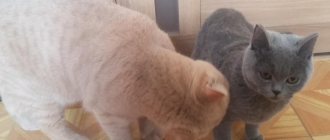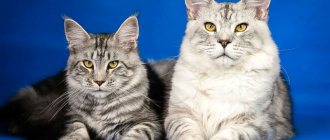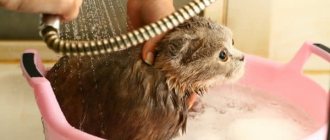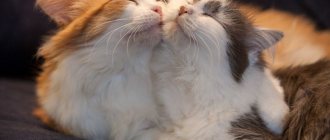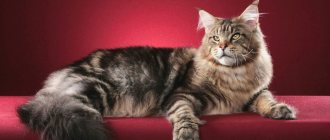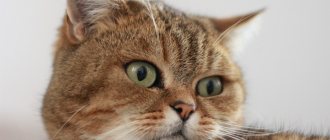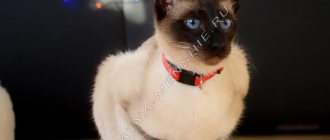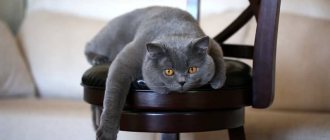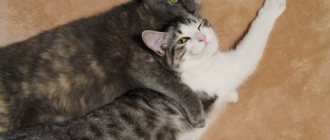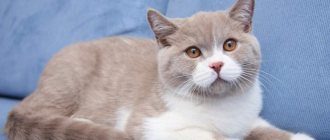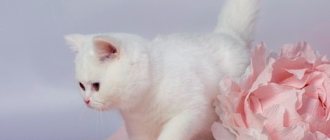Every owner of a British cat sooner or later must make a decision: does he need mating of the animal, and if so, how best to carry it out? To organize this process correctly, you must know how puberty occurs in cats and female cats in order to understand whether they are ready for mating, as well as study all the rules for organizing mating and preparing the animal for it.
When does puberty begin in cats?
The onset of puberty usually occurs at 6-8 months. At this point, the first heat is often observed. At the same time, there can be no question of any mating. Although, if you don’t have a good cat in mind yet, then it’s worth starting an active search. In order to bear and give birth to healthy offspring, the cat must become stronger and “formed”. This is possible no earlier than the animal is one to one and a half years old . Some owners rush, but in vain, because then dead kittens are born, and the cat begins to get very sick.
It is better to skip the first 4-5 heats in British cats and only after that think about offspring.
As for cats, their puberty period is 7-8 months. Although the male feline will also not be ready for fatherhood at this age. It is recommended to wait at least up to a year.
Breeding British cats
Breeding British kittens is not only a pleasant activity for lovers of the breed, but also quite profitable. However, so that all efforts are not in vain, first of all you should understand the basic principles of breeding:
- The pedigree of the cat is of great importance in breeding. At least 4 generations of ancestors must be British with a certain coat color. It’s even better if his “relatives” have awards and titles behind them (as confirmation of the breed).
- You should learn to distinguish between a British Shorthair and a Scottish Shorthair Straight cat. Despite the fact that the breeds are quite similar in appearance, most clubs do not register their offspring. This is explained by the fact that a straight-eared Scotsman almost always carries the gene for lop-earedness, therefore, as a result of crossing such animals, one can get lop-eared kittens, even with unclear characteristics. For the British cat breed this is considered a marriage.
How to buy
To avoid purchasing a mongrel instead of a purebred pet, it is better to buy a British kitten from a breeder. The cost of a real Briton is quite high - 10-18 thousand rubles. However, this price is worth it to get a healthy and properly raised pet.
Documentation
When purchasing a British breed kitten, the breeder is required to issue the following documents:
- Veterinary passport.
- Pedigree.
- Document of purchase and sale.
Only with these documents will you be able to breed kittens and take part in exhibitions.
When to think about mating
Most owners of four-legged cats do not know when to breed a British cat. People are afraid of making mistakes, so they delay the process.
Characteristic signs of a cat are:
- Loud and constant shouting. This is how the pet tries to call the cat to her.
- Constantly rolling on the floor and licking your genitals.
- A sharp change in mood - the animal can either be too affectionate, or, on the contrary, show unreasonable aggression.
- While stroking, the pet arches and raises its tail. In this way she shows that she is ready to meet the cat.
For a cat, things are a little different:
- Animals begin to actively mark all corners in the house. Attempts to scold the cat do not lead to anything good; he tries even more actively to show what he needs.
- The cat rubs against sharp objects or those that interest him. Often people observe some kind of friction, body movements are directed towards the thing that the pet is interested in.
- Pets change dramatically. Some people do not recognize cats as their four-legged companions.
Important! There is no need to try to calm or scold the animals at this moment. Instincts that are higher than everything “awaken” in them.
If the pet is already ready, then it can happen to someone; if offspring are not included in the plans of the owners, then it is more humane to perform sterilization so as not to torture either yourself or the pet.
Exterior manufacturers
In addition, you should pay attention to the exterior of the manufacturers in general. You should not bring your pet with a cat that has too light a bone, a small head or a stretched body. Particular attention should be paid to the applicant's eyes. They should not be oblique. It is also not allowed to have an extra claw on any of the paws. Both of these characteristics will certainly be inherited.
Mating of British cats is usually carried out only with cats that have diplomas. The pedigree should be checked up to the fourth generation. Of course, it’s better if there are champion animals in dad’s family. You can't mix Britons with Scots.
Mating cats basic rules for owners
Mating of British cats should be carried out based on several rules.
They are as follows:
- Mating usually takes place in the male's territory. The reason is that cats take much longer to get used to a new place. In addition, they first mark the territory, and only then begin to settle into the apartment. In practice, there were enough cases when a cat recorded the entire house and things didn’t go further than that.
- By sending your cat to a cat, you should make her stay much more comfortable. Having your own house, you must take it without fail. The same applies to the food bowl, water plate, as well as the food to which the pet is accustomed. If the cat is very picky, then you will also need to take a tray. With these items the animal will feel calm and protected, which will help it adapt better and faster.
- Before the trip, you need to cut your cat's nails so that it does not scratch the cat, and also vaccinate your pet. It wouldn’t hurt to “drive away” fleas and worms. When fulfilling all these points, it is recommended to hint about them to those owners to whom the cat will go. Otherwise, instead of the expected result, you may catch some disease or return home scratched.
Pros and cons of the breed
Each breed has its pros and cons. The British cat has a unique character that combines an insane love for people, but does not exclude pride and willfulness.
Advantages of the breed:
- good health;
- friendly and affectionate character;
- independence;
- cleanliness;
- fit well into families with children;
- easy care.
Despite its advantages, the breed has its own small characteristics.
Disadvantages of the breed:
- often overeat and gain weight;
- needs expensive food;
- wayward character, British individuals cannot be trained;
- the pet decides for itself where its personal boundaries lie.
Despite the disadvantages, British cats are still a popular breed. The cat will immediately become a full-fledged member of the family and will delight its owners with its kind character.
Interesting!
The British Shorthair cat ranks 5th in the ranking of the 20 most popular cat breeds in the world.
How often do British cats come into heat?
A British cat's heat begins no earlier than 6 months. Breeders note that this can happen at 5 months, but only if there is also a male living in the house with the pet. Then the pets grow up much faster. This process is also influenced by the season of birth of the animal. Veterinarians say that those born in the spring begin to walk several months later than those born in the summer or autumn.
In addition, the animal's temperament can also affect estrus. It is not uncommon for the first rumblings to begin only at the age of one. And this is the norm. As for the frequency, this is all individual. About 20 years ago, spring was considered an active period, when nature woke up and animals “woke up” with it. Today, heat can occur at different times in different ways. In spring, the frequency is observed every 3 weeks, in summer – once every 2 months. A cat may ask to go for walks at least six times a year.
How to recognize pregnancy?
Often the first mating of straight-eared British dogs is successful. 2-3 days after crossing, the cat calms down and sleeps. At the end of the third week, the pet’s appetite worsens, and due to nausea, she even refuses her favorite treats. When the second half of pregnancy begins, the desire for food returns, and the appetite becomes good. The cat prefers to sleep most of the day. On day 21, her nipples swell and turn red, and you can already notice a rounded tummy.
10-14 days before the expected date of birth, the cat looks for a cozy place. The owner is recommended to offer the pet a cardboard box, the bottom of which is lined with soft natural fabric. When the cat has completely equipped her nest, she will calm down and begin to wait for the offspring to appear. In order for the birth to take place without complications, it is also important to prepare properly, if necessary, consult a veterinarian and agree to contact him if something suddenly goes wrong. Veterinarians do not recommend breeding a British cat more than 3 times a year. Otherwise, the animal’s body will weaken, which will negatively affect the health of the cat itself and future kittens.
How long does a British cat go into heat?
A British cat can only be mated when she is in heat. However, the problem is that not everyone understands when the process began and how long it will last. It can be assumed that the first day is considered to be the one when the pet’s behavior changes dramatically. Most people wait for the cats to scream, not suspecting that the countdown must begin from the moment when the behavior of the four-legged animal changes.
She begins to fawn over her owner (which is usually uncharacteristic of British women), licking herself longer than usual. This does not last long - one, and sometimes two days. The next stage can make the owner nervous, because it lasts about a week and is characterized by the cat’s yelling, as well as all the other nuances that were described above. Afterwards everything ends. That is, in general, cats walk for about 7-10 days. The first time, this period is much shorter and amounts to no more than three to four days.
Photo and video
Photo:
Video:
Video: British Shorthair cat
Video: British Shorthair - breed overview
Video: British cat - owner’s opinion about the breed
Pure-blooded British people are distinguished by their kindness and sensitivity. These are true partners and true friends. Their maintenance does not require large material costs, and time spent with them gives real happiness.
Selection of a partner
Not every cat will have a cat for a walk. Therefore, choosing a partner is an important point that should be given maximum attention. In addition, you need to pay attention to the color of the animal. If the owners are going to breed babies for sale, then they should look for a cat based on the shade so that they get what they want.
So, white British people cannot be mixed together, because the offspring may turn out to be deaf. When you want to breed a tabby, it is better that the partner is blue or black. At the same time, brown or chocolate shade is not an option at all. If the cat is light cream or black, then you can choose a cat of the same color.
When choosing a male, you should also pay attention to his health and appearance. Strong cats are the guarantee that babies will be born healthy and strong. When mating with a British cat for the first time, you need to choose an experienced animal. Otherwise, both she and he will start hissing at each other and fighting. If the cat is more courageous, then she may not even drive the male into a corner and not let him out until she is taken away. Therefore, special attention is paid to this nuance.
British cats - description of the breed
The history of the origin of British cats goes back more than 2000 years. Since these animals were distinguished by good health and extraordinary agility, the Romans brought them to the islands of Great Britain as rodent hunters.
Historical facts . . . The British became especially popular in the 19th century, when they began to be considered purebred and shown at various exhibitions.
Compact and at the same time powerful cats of this breed are distinguished by dense hair, thanks to which they look like real teddy bears!
Types of British cats
British cats can be of two varieties:
- shorthair
- long-haired
Types of British >> What does a British cat look like >>
Despite the fact that the coat of British women is most often blue, you should know that there are other types of colors.
British shorthair
Representatives of the British Shorthair cat breed are considered bear-type animals, since their fur is amazingly delicate and dense.
This smooth-haired cat always has the same length of fur all over its body. The average length of one hair of a British Shorthair is 2.4 mm.
A disadvantage of the British Shorthair cat can be the irregular texture of the coat - it should only have a fine ivy-like texture.
Fold-eared Briton - reality or myth>>
British Shorthair
Longhaired British
British Longhairs
The peculiarity of the British Longhair is its straight, fluffy coat of medium length, which gradually increases from head to tail.
A long-haired chinchilla cat always has a good undercoat with dry guard hairs, as well as a developed “collar” and “pants”.
To participate in exhibitions, a British cat with long hair can be of any color, except a combination of white and color point. How to name a British kitten >> How to name a kitten by the length of its fur >>
Mating cats: basic rules for owners
During mating, a number of simple rules should be followed. This is the only way to get the result you expected.
These rules are:
- If the cat is already more than one and a half years old, the first signs of estrus have become noticeable, there is no need to wait any longer. It’s bad to bring animals in early, but you shouldn’t overexpose them either. A nulliparous pet may experience problems in the reproductive system. Some beauties cannot bear offspring, others' babies are stillborn, some have to undergo surgery to get kittens. In a word, it’s bad to start mating early, but there’s nothing good about mating too late.
- After bringing the cat to the cat, you need to observe the animals for some time. Sometimes there is such strong aggression on the part of one that the four-legged animal is ready to kill if only it would be spared from the company of a stranger.
- During mating, it is better not to be near the cats, because people can distract them from the process.
- You should leave the cat with the cat for no more than 2-3 days. Firstly, after this time, males lose interest in females, and secondly, a large amount of “ovary” will lead to the fact that some kittens will be born premature and weak.
Should you give your cat birth control?
Usually cats, not getting a cat during the onset of estrus, move on to the next active phase - they scream day and night, preventing their owners and their neighbors from sleeping. Owners, unable to withstand such torture, often resort to advertised hormonal drugs (Contrasex, Anti-Meow, etc.), after the use of which hormonal disorders occur in cats, which cause severe diseases of the reproductive system - infertility, endometritis, pyometra (“purulent uterus”), malignant neoplasms, deformities of offspring, etc.
This is a very important issue that requires separate consideration. Many cat owners consider such medications to be an alternative to sterilizing their animal, but this is not true: contraceptives cause irreparable harm to your pet!
In this case, pathologies of the reproductive system can occur only after a few years, when the cat is already elderly, and you will have to either decide on a risky operation or euthanize the animal. Therefore, if you do not want to endure regular heat and the cat’s behavior after mating, it is better to immediately sterilize your pet, which will not only save you from the hassle of organizing mating, but will also protect your cat from serious and dangerous diseases.
5 / 5 ( 319 votes)
How does mating work?
Having noticed that the cat has changed in behavior, you need to observe it for a couple more days, and then you can take it to the cat. This is usually done 3-4 days after the start of the party. It is better for the cat owner to prepare in advance the room where the animals will live for these couple of days. First, a cat is brought into the room, which must get used to it a little, and only after that can a male be introduced. If the male representative does not show interest in the lady, you should wait a little.
Some breeders recommend raising the cat's tail and holding the cat up to it so that he can smell the scent. If the cat is indifferent to its partner, there is no need to rush; perhaps it has not yet gotten used to it. There are times when animals begin to fight and hiss at each other. Having noticed active aggression, it is necessary to stop everything.
Inexperienced pets may not understand what to do and may grab incorrectly. If this is the case, then you can give the cat a little encouragement and help him (but inactively) in carrying out this process. The fact that everything went well is evidenced by the cat’s screaming, its rolling on the floor, as well as its active licking of its genitals. When a cat hides or hides in a corner, this is a sign that the male did not please her in some way. In this case, it is also not recommended to “insist” and it is better to take the pet home.
Abbreviated breed names
| ABY | Abyssinian |
| BAL | Balinese |
| BOM | Bombay |
| BRI | British |
| BUL | burmilla |
| BUR | Burmese |
| CHA | Chartreux |
| CIM | Kymrik |
| CRX | Cornish Rex |
| DRX | Devon Rex |
| DSX | Don Sphynx |
| EUR | European KSH (shorthair) |
| EXO | exotic KS |
| GRX | german rex |
| JAV | Javanesian |
| J.B.T. | Japanese Bobtail |
| KBL | Kurilian Bobtail DSh (longhair) |
| KBS | Kurilian Bobtail KSh |
| KOR | korat |
| MAN | Manx |
| MAU | Egyptian Mau |
| MCO | Maine Coon |
| MUN | munchkin |
| NFO | Norwegian Forest |
| NEV | Neva Masquerade |
| ORI | oriental |
| PTB | Peterbald |
| PER | Persian |
| PET | domestic cat |
| RAG | ragdoll |
| RUS | Russian blue |
| SBI | sacred burma |
| SCS | Scottish KS |
| SCL | Scottish DS |
| SFL | Scottish fold DS |
| SFS | Scottish fold KSh |
| SIA | Siamese |
| SIB | Siberian |
| SIN | Singapore |
| SNO | snow shoo |
| SOM | Somalia |
| SPH | Canadian Sphynx |
| TUA | angora |
| TUV | turkish van |
Non-standard situations that may occur when mating cats: rules of conduct for owners
Sometimes not everything works out the way you want. Therefore, you need to be prepared for this, and also know what to do in such situations.
The rules are simple:
- If the cat is smaller in size than the cat, which happens in some cases, then he will not be able to grab the female’s withers and then perform a love act. That is, there will seem to be an act, but there will be no contact of the genitals. In this case, a person can take the pet by the withers so that the cat grabs the skin below. This way the organs will be at the same level and the problem will go away.
- When a cat does not let the cat near her either for the first time or during the next heat, this is a reason to contact the veterinarian. The doctor will insert a four-legged special probe into the vagina, which will solve the problem. Sometimes a special drug should be administered to “awaken” the cat’s instincts. However, this is up to the veterinarian to decide.
- Some cats fall on their side during mating and it is difficult for the cat to start the process. There are people who try to force a cat onto a female and do everything themselves, but this is stressful for both animals. Breeders note that the partner will be able to penetrate the cat in this position, so it is better not to interfere.
- When pets enter a new home, they often forget about the purpose of their visit, their character changes, and they become indifferent. In this case, it is better to wait a little. If the four-legged pet does not get used to it, then there is only one thing left to do - postpone mating until another time.
Important! Animals, like people, also have their own preferences. Therefore, if a cat is indifferent towards each other, there is no need to try to force them to “marry”. This could end badly.
Coat color
Thanks to the work of breeders, more than 30 shades of wool are known that are found in British Shorthairs. Color information is still changing.
Plain
The British shorthair cat is in particular demand. Brief description – plain fur without spots, stripes, or hairs of a different color. In general, there are 7 variations of solid colors in the breed, including cream, chocolate, white, black, lilac, red and red.
Tortoiseshell
The coat combines 3 different shades, often with one of them being dominant. Each tortoiseshell color is unique, it is impossible to find 2 identical colors. Officially, there are only 80 color variations.
Chinchilla
Chinchilla is a favorite color of many breeders. The attractiveness of the smoky color can be assessed from the photo. It appeared relatively recently, but quickly won love among buyers. This is an expensive color and difficult to breed. The gold variety is in demand, but there is also a silver variety. The main characteristic of the colors is soft tones.
Important!
The golden variety is crossed only with the golden color.
Tabby
Tabby cat is a brindle color. Tiger stripes stand out clearly against the main, lighter background. The striped coloring can be presented in black and silver or in a brownish-red shade. The Whiskas advert featured just such a tabby kitten. There is a marbled type of fur, when the stripes turn into various patterns.
Bicolor
The main thing in describing the color is the combination of 2 different shades. Gray and white, which is shown in the photo, is common. At the same time, it unevenly covers the fur, forming various spots. Often the paws are dressed in white socks, sometimes the tail is highlighted.
The hair grows short, which creates the feeling of plush fur. There are tricolor colors, where 3 shades are combined at once. For example, a combination of gray, red and white.
Color Point
The British Shorthair cat is distinguished by an abundance of colors. There is even a Siamese color point. In another way, the color is usually called the Himalayan color. The main feature is the contrast of color spots. The main color of the coat should be light, and the mask on the face, ears, tail and paws should be dark.
Signs of pregnancy
Signs of pregnancy can be observed by the cat's behavior. Two weeks after mating, the animal becomes calmer and sleeps a lot. In addition, you may notice that the pet loses its appetite, sometimes it feels nauseous and vomits. From the third week, the nipples turn pink and enlarge. And after another week, the fluffy begins to eat a lot. An enlarged belly is observed in the fifth week. Considering that a cat is pregnant for about 65-67 days, you can monitor the animal’s behavior from the first day of mating. If after three weeks no changes have occurred, then you need to wait for another heat.
If everything worked out, kittens appear after two months. The next mating after birth can be planned no earlier than 7-8 months later.
Pregnancy and childbirth
British cats, like others, are pregnant for 64-70 days. If fertilization does not occur, then estrus begins 3-4 weeks after the unsuccessful attempt. The first signs of pregnancy are visible at 3 weeks.
The nipples become pinkish and slightly enlarged. The British woman becomes more tender, demanding affection and attention. Then the rest time increases.
After 4 weeks, the fruits and their movements can be felt. In one litter, British women give birth to an average of 3-5 kittens, in some cases multiple births are possible - up to 9 kittens.
This factor depends on heredity; if a female cat in her family gave birth to more than 5 kittens, then she has every chance of the same result.
A few days before giving birth, the expectant mother is looking for a place where she can comfortably produce and raise her offspring. As a rule, these are drawers or cabinet compartments, the space under the sofa, or the bathroom. Some cats come to their owners' beds to give birth.
Important: In the second half of pregnancy, cats are not allowed to jump from heights, play active games, or have contact with other animals.
Set up a box or house with bedding made of dense materials that are rigidly attached to the walls. Soft and thin sheets are unsuitable; during childbirth, the cat may accidentally wrap the kitten and cause harm to it.
Childbirth sometimes goes unnoticed and without human intervention, but it is better to observe the process and be prepared for unforeseen situations. British women in most cases give birth on their own; a caesarean section is rarely necessary.
The cat notifies about the beginning of the process by restlessness and meowing. You need to talk to her kindly and prepare the maternity ward. The process can last several hours, up to a day.
The kittens come out in bubbles with liquid, the mother gnaws them herself, and then removes the umbilical cord. After giving birth, the cat produces colostrum, which is nutritious and very important for babies. Soon it is replaced by milk.
British + Scots
Tell me, is it possible to match a “Scottish” with a “British”? Or should these breeds not be mixed? Tatiana.
In general, cats are not very scrupulous regarding morality, so the most common breed is RANDOM. As for their owners... You know, you can’t pick flowers from a flowerbed either, because they tear them, so and so!
British Shorthair
British Shorthair and Scottish Shorthair cats were closely related throughout the history of the formation of the Scottish Fold breed (“fold” is a fold, in this case on the ears) - Scottish Fold cats were bred with straight-eared British cats (since the gene for folding is related to to semi-lethal genes, mating between two fold-eared cats is prohibited (!), otherwise the offspring may have skeletal deformations incompatible with life, hereditary diseases, etc.)
In the British breed, mating of British with Scots is prohibited. But to maintain the pedigree data of the Scottish cat breed, matings of Scots and British cats were allowed. The kittens resulting from such a mating were always recorded in the metric as Scottish: fold-eared - like Scottish Fold, straight-eared - like Scottish Straight.
This was the case until 2004. Over time, the Scots began to differ from the British not only in the features of their ears, but also in other characteristics: the length of the body, tail and limbs. Scottish dogs have a more open muzzle with round and large eyes, reminiscent of a cute baby face. They are lighter in structure than British cats, not as large and stocky as British cats, their bodies are more elongated, their heads are round in shape, and have soft outlines. For the Scots, developed cheeks, like the British, are undesirable, which disrupt the round shape of the head. Scottish Straights also differ from the British in the size and position of their ears; their ears are smaller than those of the British and not as wide at the base. The thickness of the ear cartilage in Scottish Straight cats is less than that of British cats, and the cartilage itself is softer to the touch. The Scottish Straight has a slightly longer coat than the British.
Scottish Shorthair
The Scottish Straight differs from the Scottish Fold only in having straight ears. And therefore, in 2004, the Scottish Straight breed was registered with the WCF (World Cat Federation) as the “Scottish Shorthair” breed with the right to participate in the championship.
All standards of the Scottish breed must be preserved, so today they mainly breed Scottish Folds with Scottish Straights and very rarely breed with British dogs, especially since such interbreed matings have been prohibited in the WCF since 2004.
A British cat can only be crossed with a British cat. Kittens born as a result of mating a British cat with a representative of another breed are not considered British.
Mating of British and Scottish cats -2
The profile of the blog is cat health, so all issues are considered in this vein.
For an introduction, a little about genes (literally on the fingers):
At birth, every organism receives each gene twice—one from the father and one from the mother. If these genes are different, then the individual will be heterozygous for this gene, if they are the same, then homozygous . The main, stronger, suppressive gene is called dominant , and the weaker, suppressed gene is recessive .
For example, both parents have dark hair, which means that the child receives two identical genes (dark/dark) responsible for hair color, that is, he is homozygous for this gene and his hair should also be dark. If the father is brunette and the mother is blonde, then the child’s hair color gene is heterozygous. If the father's gene is dominant, then the child will turn out to be dark-haired (dark/light), but he will be a carrier of a recessive light gene (perhaps someday in other generations this light-hair gene will appear). May the geneticists forgive me, in reality everything is much more complicated, but for the concept of lop-eared genes this will be enough.
Who is the Scottish Fold?
This is a mutant.
Why can such a cute creature be called a word from a horror movie? Yes, because Fold is the owner of an “abnormal” mutated cartilage gene that is unable to support the weight of the ear in a standing position.
Ears are the main breed characteristic of the Scottish Fold cat. According to the standard, they should be small, with slightly rounded tips. Curved forward and directed towards the middle of the muzzle, the ears are pressed tightly to the head, which gives it a round shape.
What's hiding behind those cute little ears? Osteochondrodysplasia. Do you think the cartilage tissue mutant gene only affects the ears? No matter how it is!
Cartilage is an important structural tissue that provides support to parts of the body that do not have bones. Cartilage is also closely connected to bones, providing a smooth surface of the joints, ease and painlessness of movements.
Cartilage plays an important role in the growth and formation of bones in young animals. The fetal skeleton initially consists of cartilage, which is gradually replaced by bone. Growth in bone length is associated with the establishment of cartilage in special parts of the bone - disc-shaped growth plates. In a process called endochondral ossification, cartilage is replaced by bone tissue.
Thus, abnormalities in cartilage development can have major consequences for joint and bone formation.
In Scottish Folds, a cartilage abnormality due to a mutant gene can manifest itself in disorders of the musculoskeletal system, shortening of bones, fusion of the vertebrae and thickening of the joints, which causes lameness, chronic pain, and deformation of the limbs.
This is the gene for lop-earedness! That is, in the Scottish breed, initially at the genetic level there are anomalies in the skeleton and, consequently, in health in general.
The Scottish Fold breed originated in Scotland in the 1960s. And although it was initially recognized in the UK, in 1974 it was excluded from the list of recognized breeds due to harm to the health of cats due to deformation of the limbs and tail. The breed is also banned by the International Cat Federation and other organizations as inhumane. The breeding of the Scots was transferred to the USA, where geneticists found a solution that made the existence of the breed possible.
Who to breed a Scotsman with?
Mating of two folds (homozygous mating)
It would seem that the most natural way to fix the fold-eared gene in a breed (let’s denote it Fd ) is the mating of two folds. But it is then that negative manifestations of the mutation occur in the offspring.
The result of mating two folds is osteochondrodysplasia. The abnormality of the cartilage that causes the ears to “float” has a devastating effect on other parts of the body, especially the limbs. Homozygous cats have an abnormally thick tail that is rigid at the base. This is due to abnormally short, wide, and fused vertebrae. The legs are short with deformed limbs. The metatarsals, metacarpals (bones that connect the fingers and wrist), and hock joint (ankle/paw) are distorted and widened.
Over time, inflammation and pain begin in the joints of the lower extremities - osteoarthritis. Exostoses (growing bone formations extending beyond the surface of the bone) form around them. This occurs due to defects in endochondral ossification in these bones. The result of these processes is deformation of the limbs, a decrease in their ability to bear a load, gait disturbance, lameness, and chronic pain. The progression of these abnormalities leads to the fact that affected cats cannot walk.
The pathology can become apparent in cats as early as seven weeks of age and persist throughout life.
Thus, the lop ear gene in homozygous form ( FdFd ) is dangerous! Therefore, for all felinological systems there is a ban on mating fold + fold
Mating of fold and straight (heterozygous mating)
It is clear that in order to “dilute” the fatal gene, a fold-eared cat must be bred with a straight-eared cat (straight-eared gene fd).
As a result of such matings, kittens with the Fd fd gene sets appear - these are folds with a fold on the ears (since the Fd is dominant) and fdfd are straight-eared straight cats. Now the terrible combination of FdFd is no longer present. It would seem that the problem with osteochondrodysplasia has been solved. Unfortunately, it is not.
And heterozygous Scots may also have primary development of limb deformities, although, of course, less severe than in homozygous individuals. And pathology (arthritis, bone exostoses) develops more slowly and at a later age. The disease can manifest itself from very mild to severe.
The diagnosis is confirmed by x-ray, computed tomography or MRI (magnetic resonance imaging).
The disease is genetic, cure as such. Animals are prescribed chondroprotectors, painkillers and anti-inflammatory drugs for joints. In some cases, surgery on the affected joints has been successfully used to remove bony exostoses to reduce lameness and pain. Currently, radiation therapy has also begun to be used. Particularly affected animals are subject to euthanasia.
Kittens
From a breeding point of view, the Scots breed is interesting for its unpredictability. It's just some kind of lottery. You can never know exactly how many folds ( Fd fd) and how many straights (fdfd) there will be in a litter (theoretically 50 to 50, practically...).
All Scottish kittens are born with straight, erect ears. Around the 21st day, some kittens' ears begin to fold - these are future folds. Those kittens whose ears remain unchanged are straight. But here lies another catch.
Over time, the ears of folds may partially stand up, which is very sad from the point of view of breeding. It happens that it is difficult for the untrained eye to distinguish a real straight from a “straightened” fold. And then there is a risk of crossing fold with fold out of ignorance, which is not good. Eh, when will a genetic marker appear to clearly identify the Fd from a blood or saliva sample?!
From questions to the first article:
— Tell me, the kitten’s ears are starting to rise a little, can they stand up at all? And then I can turn him into a straight guy, even though his ears were hanging when he was a child?
— Tell me, please, if I have a Scottish Fold cat with erect ears, is it possible to breed with a Scottish Fold cat also with erect ears, or will there still be deformities?
- Hello! I have a British cat and a straight-eared Scottish cat, can their mating result in fold-eared kittens?
Answer:
If a kitten receives the Fd fd (loose-eared) set of genes from birth, then it remains that way for the rest of its life, regardless of whether the ears straighten or not. He always! will be considered a fold. A fold can only be knitted with a straight.
Straight-eared cats have a set of fdfd genes, and the fold-eared gene Fd will not appear from their mating. That is, two straights (whether Scottish or British, it doesn’t matter) will not fold!
Mating of British and Scottish cats -3
Why Scots can't be mated with Britons
Why not? After all, this is what they did before - a fold-eared Scot was mated with a straight-eared Briton, and everything was in order with the gene set. The British were used as material to obtain the recognized Scottish Fold breed (there was no Scottish Straight breed as such). Until 2004.
In 2004, the World Cat Federation (WCF) officially registered a new Scottish Straight breed with the right to participate in the Championship. Hooray!! Thus, in Russia, the Scottish straight-eared cat has become an independent breed with its own mandatory standards. And these standards differ from the standards of other breeds, from the British in particular.
At the same time, in 2004, a resolution was adopted to ban cross-breed matings, since from now on the Scots and the British are two completely different breeds, having different standards and a different point scale at the Championship. Like this!
Single matings can now be carried out only for the breeding work of the club, accompanied by a reasonable entry in the club’s stud book, the issuance of an experimental pedigree and further control over the offspring.
In the United States, the Scottish Fold is still bred to British or American Shorthair cats. Well, they don’t have the Scottish Straight breed, but we in Russia do!
So, since 2004, the mating of a Scotsman and a Briton is an interbreed mating that blurs the breed characteristics and thereby worsens both breeds. The result is an average standard, neither this nor that. The main feature of the Scottish Fold – the ears – also suffers. More on this below.
But it's not just a matter of distortion of the breed. Health also suffers.
The British skeleton consists of short, powerful bones. Scottish cats have much lighter bones, a more flexible and longer tail, and more elongated caudal vertebrae. And this reduces the risk of skeletal disorders due to an abnormal cartilage gene.
Well, the British don’t need mating with the Scots in any way at all, since it doesn’t give anything, but only spoils their breed characteristics. British kittens are born only from a British couple!
Why should Scots be bred with Scots?
Thus, mixing the Scots with the British is bad. But with the Scots it’s good. Why?
For Scottish Folds, the main asset of the breed, which brings a significant part of the points at exhibitions and championships, is their ears. Initially, representatives of the breed simply had ears that “hung”, bending forward. Now, thanks to selection work, they have two or even three folds. The breed standard requires that fold ears be small, folded and not protrude beyond the contours of the head. Therefore, the task of breeders is to achieve maximum fit of the ears to the head.
And this factor is significantly influenced by modifier genes .
Scottish Straights, having straight ears, still carry hidden genetic information about the lop ears of one of their parents, which is passed on to the next generation.
Therefore, by crossing a lop-eared cat with a cat that has modifier genes for the same lop-earedness, you can achieve the best results in the offspring and get excellent show-class animals.
The British do not possess these modifier genes. And when interbreeding a Scottish Fold with a British dog, the result is kittens whose lop ears are based on the genetic material of only one parent - the Fold. The tightness of their ears often leaves much to be desired. Such kittens may have one sweet ear on their ears, and they are directed to the sides, and over time they can stand up. And such ears can turn out to be much wider and more powerful than the standard prescribes. Alas, not an exhibition option.
The Scottish Fold differs from the Scottish Straight only in its ears; all other breed characteristics are the same. Therefore, crossing them with each other improves the breed.
And, of course, mating two Scots, who have a lighter frame compared to the British, significantly reduces the risk of negative consequences of the mutated cartilage gene in offspring.
And finally about the patient.
So, Russia, having recognized the Scottish Straight breed, found itself “ahead of the rest.” It would seem that all owners of Scots should rejoice and throw all their efforts into improving the young breed. But no! Everything in our country is again... not as it should be.
Some of the “breeders” (put in quotation marks) still continue unjustified interbreed matings with the British under the slogan “they bred before, and nothing…”, thereby grossly blurring the breed characteristics.
Moreover, in order to get a litter consisting 100% of the popular Folds, completely unscrupulous owners cross Scottish Folds with each other, not caring at all about the health of the kittens.
What could this lead to? To the appearance of a layer of sick animals of an unknown breed. And they will ban the Scots here, like in Europe, and that’s it!
From the comments to the first article:
— We bought a kitten, Scottish fold, female, at the age of 1.5 months. After a couple of months, the ears straightened, not quite of course, they seemed to be directed forward, and the muzzle, it seems to me, became somehow sharper, although with cheeks. Now I have doubts about what breed my favorite belongs to, and what kind of offspring I should expect (my friends were promised kittens from our cat).
— The kitten’s mother cat is a cross between a Fold and a Straight, and the father is a breeding Fold — that’s what the breeder wrote to me... I look at the photo, the mother’s ears are neither this nor that... they don’t stick out like the British, for example, but they don’t hang like my kitten...
Answer:
Dear cat lovers, especially those who are just planning to get a kitten! If you want a healthy and purebred baby, contact clubs or real responsible breeders - where work with genetic material is carried out competently! Documents are required. It may be more expensive, but this is a guarantee that you will get a strong pet that meets all breed standards.
Don’t be fooled by advertisements like “I’ll sell a British lop-eared dog for 3 thousand rubles.” Unfortunately, our illiteracy contributes to the prosperity of such would-be breeders.
Of course, this applies to all breeds. But this is doubly true for the Scots breed, since it has genetic “pitfalls” that, if handled incorrectly, can lead to big problems.
The Scottish cat breed is interesting and unique. So let it be!
From the comments:
- Hello, I have a question. I have a Scottish Fold cat, if I cross her with a British cat, will the kittens be British or Scottish?
No comments.
caticat.ru
And a little about secrets.
The story of one of our readers, Irina Volodina:
I was especially distressed by my eyes, which were surrounded by large wrinkles, plus dark circles and puffiness. How to completely remove wrinkles and bags under the eyes? How to deal with swelling and redness? But nothing ages or rejuvenates a person more than his eyes.
But how to rejuvenate them? Plastic surgery? I found out - no less than 5 thousand dollars. Hardware procedures - photorejuvenation, gas-liquid peeling, radio lifting, laser facelift? A little more affordable - the course costs 1.5-2 thousand dollars. And when will you find time for all this? And it's still expensive. Especially now. Therefore, I chose a different method for myself.
Mating of purebred cats is a responsible procedure. Breeders are required to monitor the purity of the breed to avoid deviations at the genetic level. But there are features of some purebred animals in which representatives of the same subspecies are simply not recommended to be mated with their own kind (we are talking about the Scottish Fold and British breeds ).
with whom can you breed a Scottish Straight cat?
Guest book
Good afternoon! We recently adopted a kitten, as we were told, a British blue cat. Both mother and father are blue, I personally saw them, beautiful animals. but the kitten we booked turned out to be something other than blue))) I attached a photo of the cat (about 1.5 months old), please tell me what color it is, maybe something will change when it grows up. and in general she doesn’t quite look like a British woman. Thank you in advance
there were two matings. both successful - one time 6 kittens, the second 5 kittens. Once I ran into a pet store to get some vitamins for my pussy, she is now my nursing mother. And the sales consultant in the store asked me which cat we bred the cat with. When she heard from me that we bred her with a British straight-eared cat (I didn’t know that there were British fold-eared cats before), she was shocked! and told me. that we were lucky that the kittens turned out and were not born dead! she told me that a straight-eared British cat cannot be bred with a straight-eared British cat, otherwise very serious problems can arise with the kittens, if of course they happen with the cat too, up to her death or problems with the uterus.
Stunned by such news, I ran home and began to rummage on the Internet))) but unfortunately I couldn’t find anything like that. And who should I breed her with now? You can’t do it with the Scots, and you can’t do it with the British either))
Maybe you can tell me if this is really so. otherwise I don’t know what to think, the thought that I could harm the cat makes me feel bad. Unfortunately, I don’t have time to go to the vet, so I decided to consult with you) Thanks in advance.
At the moment, matings of British and Scottish dogs are prohibited. They have different skeletal features and such matings can lead to congenital skeletal abnormalities.
body - in the British - the body with paws fits
Source
with whom to breed a Scottish fold cat
Highland Fold (Scottish Fold Longhair)
Not long ago, a new breed of cats appeared; for many breeders of Scottish Folds, the question often arose when shaggy offspring were born from two short-haired parents - what is this, a new species or a breeding marriage? And this fact was incomprehensible, since the pedigree included only folds, straights and British. For a long time, breeders did not want to admit the fact of long hair in Scottish Folds, and most were generally afraid of the birth of this kind of kittens. Later, this breed was practically forgotten, but disputes over long hair still continued. Moreover, this situation influenced the development of long-haired cat breeds, and in particular the breed called Highland Fold .
The Scottish Longhair cat has a rounded head with a strong chin on all sides, a high and dome-shaped forehead, and a powerful neck. Males are distinguished by developed cheeks, a short and wide nose with a smooth transition. The cat's ears are folded down and forward, and the long hair gives the impression that they are completely absent from the head, the eyes are round and large, set wide apart. The body is medium, the legs are not short. Paws are round in shape. The tail is of medium length, flexible and tapered. Wool is light and soft, elastic and silky. Its length is average, shorter on the muzzle, legs and shoulders, longer on the belly and tail.
The Highland Fold cat, in addition to its unusual appearance, has many positive character traits. This breed is distinguished by its calmness and balance, with a playfulness that does not disappear throughout its life.
Many lovers of the Scottish Longhair cat are familiar with this situation, which surprises: the cat often gets into the dog pose when it hears an unusual noise, or sits in the Buddha pose when
Source
